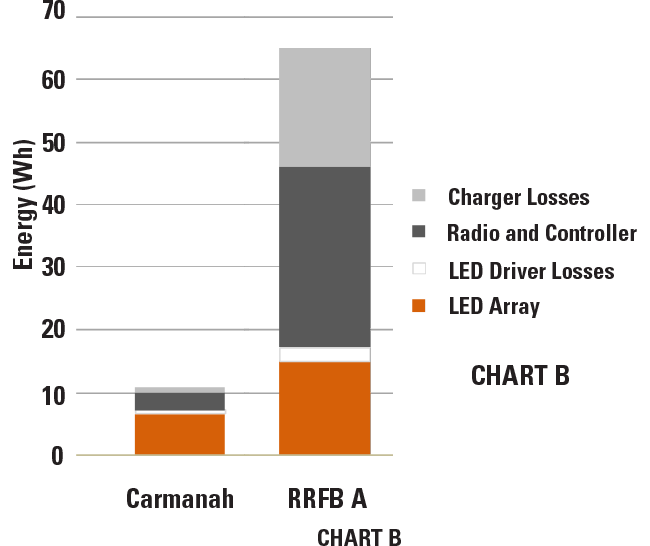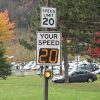FACTORS AFFECTING ENERGY IN AND ENERGY OUT FOR SOLAR POWER BEACONS
ARTICLE 1 of 4 | This is the first article in this series focusing on understanding solar power for traffic beacons and signs.
Not all beacons are created equal. To ensure solar powered beacons maintain a reliable operating capacity and provide sustainable performance, it’s important to first understand the elements involved in both energy in and energy out. Let’s use rectangular rapid flashing beacons (RRFBs) as an example since they have the most variables to consider.
Energy In

Energy in is site-specific and considers four factors. First is the power coming in from the solar panel, which is dependent on the second factor, the number of sun hours or insolation available at a specific location. Third is the charge efficiencies of a system, which vary greatly between manufacturers. Efficient charging technology, such as maximum power point tracking (MPPT), can improve energy collection capabilities. Fourth, site-specific shading is an important element, yet is one of the most overlooked considerations in project specifications.
OVERVIEW: Learn how solar beacons work.
Energy Out

Energy out is application specific and is affected by many variables. For an RRFB, the number of activations, the flash duration, and the components that draw power when the system is flashing are key considerations in the energy-out equation. It is also important to factor in application options that require significantly more power, such as pushbutton voice message. Additionally, it is necessary to consider the energy continuously used when the system is off. For example, when the system is in standby, the wireless technology may consume a large amount of power. The efficiency of the optical and energy management systems is key in reducing the amount of energy consumed by the RRFB.
The amount of energy required to run an RRFB varies considerably between manufacturers. Chart A below shows the difference in energy required for an RRFB to operate per day. Some systems with significantly smaller solar panel sizes and battery capacity need up to five times the energy of Carmanah RRFB products to operate.

Total energy consumption is determined by several different factors including the system controller, radio, LED driver, and LED array. Chart B below compares the total energy consumption of another RRFB product to a Carmanah RRFB. As seen in the chart, some RRFB products require more energy for each component. Carmanah products are purpose-built and designed from the ground up. We’ve developed our radio technology, LED driver, and optics to be extremely efficient, enabling a large reduction in overall energy requirements. Energy consumption information is an important factor and should be readily available from manufacturers.

We put solar to work™—let’s get started
Performance-based specification of RRFBs and other flashing beacons is essential for an effective and sustainable solution. When considering energy balance, many variables should be factored into the equation to ensure a reliable system is specified. We have a variety of tools available to ensure all our products meet the performance requirements of your application. Our sales engineers can provide you with a custom Solar Power Report for your specific installation site.
Download this article as a PDFThe balance between energy in and energy out is an important concept. In order for a solar-powered beacon system to function, more energy needs to be collected than is consumed. NEXT ARTICLE: Learn about the array-to-load ratio.


